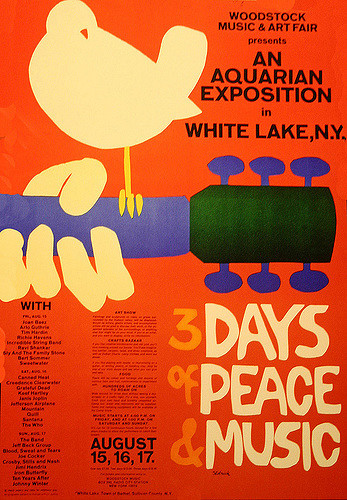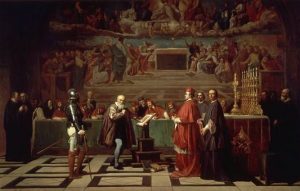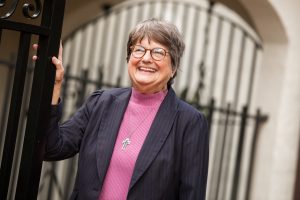The Sixties. We think of the Vietnam War, Civil Rights protests, the assassination of John F. Kennedy, the Apollo landing on the moon, hippies, Peace on Earth, and most importantly, the music. Music is how famous musicians express their thoughts and feelings to a broader audience.1 The Sixties made history through its music and more iconically, through a three-day concert known as Woodstock.

It all started with four young men that wanted to build a recording studio: John Roberts, 26-years-old, and an heir to a drugstore and a multi-million dollar trust fund; Joel Rosenman, 24-years-old, a Yale Law School graduate, and guitar player for a lounge band in Long Island and Las Vegas hotels; Artie Kornfeld, 25-years-old, a songwriter, producer, and the vice president of Capitol Records; and finally, Michael Lang, 23-years-old, and owner of a head shop that sold accessories for weed, tobacco, and other recreational drugs in Florida.2 All four men met in February of 1969 and came up with the idea of creating a rock festival, and they discussed the budget for it. They met several times after to discuss other ideas for the festival. And by their last meeting, they had a budget of five hundred thousand dollars, and were hoping for fifty thousand people to attend. Unknowingly, their “Woodstock” would become the world’s largest and most remembered Rock concert of all time.

In March of 1969, the four young men formed the Woodstock Ventures company, and each man held a twenty-five percent stake in it.3 The team now needed a location for the concert; they decided to hold the concert in a three hundred acre dairy farm in Bethel, New York, because it offered easy access from New York City, less than a mile from Route 17. And it offered electricity and water lines.4 They paid seventy five thousand dollars for the rental of the property to Max Yasgur, the owner.5 By April, Kornfeld and Lang wanted to advertise and introduce Woodstock as a place of freedom with music. They had promoters create a Woodstock image for the public. The group came up with the slogan “Three Days of Peace and Music,” because they figured, if people read “peace” in the poster, it would keep the public calm and the event free of violence. The group then hired artist Arnold Skolnick to create the image for a poster. What people thought was originally a dove on the Woodstock poster was actually a catbird, which was one of Arnold’s favorite things to draw. When Arnold finally completed the drawing for the Woodstock poster, it featured a catbird sitting on a flute along with the slogan, “Three Days of Peace and Music.” This design was approved by Woodstock Ventures. However, at the last minute, Arnold made a minor change by having the catbird stand on a guitar instead of the flute, and the poster was completed.6
Woodstock Ventures wanted the most popular rock’n’roll bands to perform at the concert. They composed contracts for each band member attending, which came with promising paychecks. They signed Jefferson Airplane for twelve thousand dollars, Creedence Clearwater Revival for eleven thousand five hundred dollars, and The Who for twelve thousand five hundred dollars.3 They had a total of thirty-two bands listed to play, including Janis Joplin, The Grateful Dead, Joe Cocker, Crosby, Stills, Nash and Young, and others. The highest paid performer was Jimi Hendrix, who signed for thirty-two thousand dollars. Hendrix would be the last act to perform and he famously closed the festival with his version of the “Star Spangled Banner,” which has gone down in history as one of the greatest performances of his career.8 Woodstock Ventures paid a total of one hundred and eighty thousand dollars for all the musicians who performed in the concert. Lang made the decision that he did not care what it would cost to get a rock band to perform for Woodstock. They would pay the deposit and create the contracts at whatever cost to ensure that they had the best performers.
By the spring time, advertisements for Woodstock started appearing in the New York Times and on radio stations across the country.9 While Woodstock Ventures had originally expected fifty thousand people to attend the festival, they sold a total of one hundred and eighty six thousand tickets, costing six dollars per day.10 In August, one week before show time, Kornfeld wanted to capture the stories of the people, their thoughts about Vietnam War, and their thoughts about Woodstock. Kornfeld made an offer with Warner Brothers to document the festival. Woodstock Ventures paid one hundred thousand dollars to have the festival filmed, and a contract was signed agreeing that if the film made it big they would get paid double the amount, and if it failed they would get nothing.
On August 14, 1969, the day before the festival, early in the morning, Woodstock Ventures noticed that traffic was backed up ten miles long on Route 17, and they were shocked to see that so many people were attending. An estimated twenty five thousand people were already waiting before the festival began.11 The four young men knew this concert was going to be amazing, but they never thought that it would go down in history as one of the biggest and “the greatest peaceful events in history,” as Time magazine called it.12

Throughout the years many attempts to recreate another Woodstock have failed. The Woodstock of 1969 will forever go down in history for its great music, the psychedelic people, and most importantly, a once in a lifetime event that can never be forgotten.
- Alan Brinkley, American History: Connecting with the Past Volume 2 (New York: McGraw-Hill Education, 2014), 812-813. ↵
- “How Woodstock Happened,” reprinted from The Times Herald-Record, 1994. http://www.edjusticeonline.com/woodstock/history/index.htm. (accessed November 17, 2016). ↵
- “How Woodstock Happened,” reprinted from The Times Herald-Record, 1994. http://www.edjusticeonline.com/woodstock/history/index.htm. (accessed November 17, 2016). ↵
- “Woodstock Music Festival.” History.com, 2009, http://www.history.com/this-day-in-history/woodstock-music-festival-concludes. (accessed November 10, 2016). ↵
- “How Woodstock Happened,” The Times Herald-Record Woodstock Commemorative Edition, 1994, http://www.edjusticeonline.com/woodstock/history/index.htm. (accessed November 17, 2016). ↵
- “How Woodstock Happened,” The Times Herald-Record Woodstock Commemorative Edition, 1994, http://www.edjusticeonline.com/woodstock/history/index.htm. (accessed November 17, 2016). ↵
- “How Woodstock Happened,” reprinted from The Times Herald-Record, 1994. http://www.edjusticeonline.com/woodstock/history/index.htm. (accessed November 17, 2016). ↵
- Spencer Bright, “Forty far-out Facts you never knew about Woodstock,” Daily Mail, August 7 2009. ↵
- “How Woodstock Happened,” The Times Herald-Record Woodstock Commemorative Edition, 1994, http://www.edjusticeonline.com/woodstock/history/index.htm. (accessed November 17, 2016). ↵
- Daily Mail, August 2009, s.v. “Forty far-out Facts you never knew about Woodstock,” by Spencer Bright. ↵
- “How Woodstock Happened,” reprinted from The Times Herald-Record, 1994. http://www.edjusticeonline.com/woodstock/history/index.htm. (accessed November 17, 2016). ↵
- Daily Mail, August 2009, s.v. “Forty far-out Facts you never knew about Woodstock,” by Spencer Bright. ↵




75 comments
Reese Lujan
I have never been a fan of rock and roll but I have heard of Woodstock and have always wanted to attend it. It is amazing to read about the startup of Woodstock and the journey the four men took into putting the festival together. So much time, effort, and money were put into such a great hit. I love seeing the famous posters that were up to advertise Woodstock.
Nathan Hudson
Who does not love rock and roll? Music is such a beautiful medium for peace and the communication of thoughts. Woodstock would have been amazing to be at. Thank you for writing such a great article that encompasses all of Woodstock and what it was. It is so cool that 4 men met and decided to create a place of peace and rock for so many people to enjoy. I can only imagine what it was like to see those bands in concert.
Olga Perez
I’ve heard very little of Woodstock before this article, but now reading about it makes me understand fully why this was such a big deal. The line-up was incredible, turn out was shocking, and everything about it was iconic. This set the precedence for what music festivals look like and try to be like now. It’s crazy to think that such a rough time in history also brought about a peaceful and harmonius event.
Isaac Rodriguez
I learned about the legendary concert Woodstock, in my junior year of high school. This article provided more insight, than my high school introduction. One thing that wasn’t mention that I’d like to say is that the concert was originally planned to be held in Woodstock New York, but concert organizers couldn’t find a location to hold the event. I’d highly recommend listening to Jimi Hendrix’ performance of the Star Spangled Banner. There are frightening sound effects during his performance, he was able to create with his guitar.
Didier Cadena
It was great to read about the backstory to probably the greatest music event in American history. I was surprised to read about how much money went into planning the event and about how much some of the more popular artists were paid to perform there. It was also great to learn about the backstory of the Woodstock’s iconic poster. This article does a great job of summarizing such a memorable event and its impact on music history.
Michael Thomas
Before I read this article, I knew that Woodstock was a concert that occurred in the Sixties. But after reading this article, I now understand the history behind Woodstock. It is interesting how four men, who wanted to build a recording studio, decided to put together a concert on farm in New York. I now see how Woodstock was the greatest concert of its time.
Joshua Breard
I think that Woodstock is the music festival that other music festivals try to be like. Many music festivals wish to obtain the level Woodstock had with attendance and popularity. The legacy of this event carries to of course music festivals but also with other musicians in creating collaborative efforts on different songs. All great things do come with a price and the financial debt that came afterwards was rough but that does not take away from this iconic event at all. Great article!
Ryann Cervantes
I really liked reading about the origins of this music festival. I’ve always heard the name and heard it referenced but didn’t really know what it was. I also like having some insight into how it was started and by who. Now I’ll have to go look up some footage of it if it really is/was the greatest music event.
Maria Callejas
This article is just awesome. You wrote so fluently and you manage to get to the point without being repetitive or dull. I had no idea about the origins of Woodstock, to be honest, I knew about this about solely because it’s a popular t-shirt design. But now I understand why so many t-shirts have been made ever since. For starters, this was the best event for any “hippie”/who wanted to de-stress from the war period in the U.S. Agreeing with you, this was much more than a music festival, but a coming together of Americans longed for peace. Also, great conclusion, it’s sad to think there won’t be something like Woodstock for us millennials.
Karina Nanez
Woodsock is such an iconic event in human history with so much media surrounding it, this was interesting to read all the planning that went into this event. I had no clue that this iconic music festival was thought up by four friends who just wanted to create a peaceful venue where fans could enjoy some the best rock music.